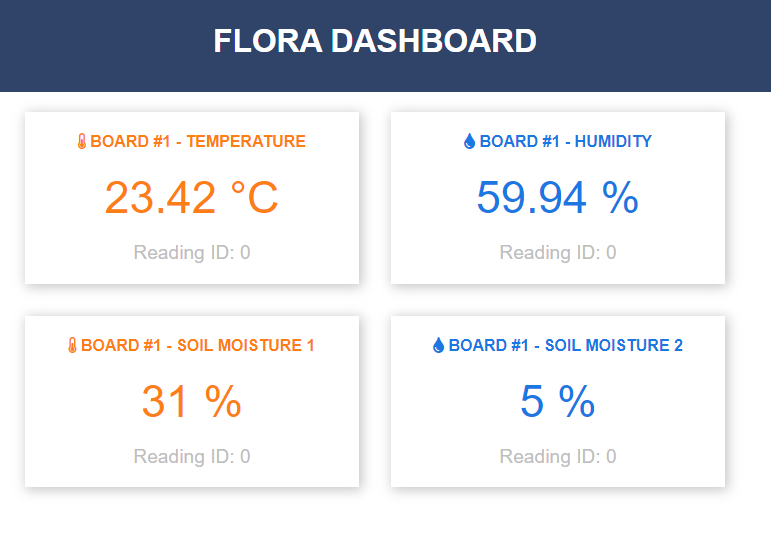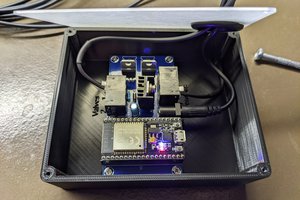Motivation
The UK has been experiencing one of its worst droughts in recent history (2022). River levels have dropped to record lows and local ponds have all dried up. This has made water efficiency absolutely crucial in preventing any significant food shortages due to low crop yield. Moreover, the preservation of our water table in rivers and lakes is also important in ensuring that other aspects of modern living remain unperturbed. E.g. In Germany, low river levels have resulted in the energy prices increasing as the coal barges are unable to transport their full load to the coal plants that need them - on top of the gas crisis affecting Europe at the moment.

What is it
FLORA is a long-range ESP-32-based garden weather station with some unique tricks. First, it has a LoRa module that allows it to be used across a considerable distance (up to around 2 miles/ 3 km). This makes it suited for use in a more extensive garden or an allotment within walking distance. On top of that, it also has a companion soil moisture sensor that can measure the moisture left in the top layer of the soil. This is particularly useful to inform you if it has had some rain locally in the area recently and to prevent unnecessary waste of precious water. The system is powered by a coin cell battery that gets recharged by a solar panel.
The project, Vinduino, by Hackaday-er Reinier van der Lee, leverages simple electronics sensors for better water management to save up to 25% of irrigation water in agricultural water consumption.
Before diving further, I have to thank JLCPCB for sponsoring this project. They have been a crucial part of the process by enabling me rapid prototype without compromising quality. All of the PCBAs related to this project were prototyped and assembled by them. I highly recommend them for the high quality, cost, and time-efficient, if you intend to design and build any boards of your own.
Building on my Plant-Bot project, I was inspired to make a version that is a little more suited for the outdoors and looking after multiple plants.
Key Features;
- Compatible with two energy long-range protocols - LoRa and ESP-NOW
- Can be powered solely by a single solar panel
- Soil Moisture sensing
- Temperature and Humidity sensing
- Easily programmable - USB
- WiFi and Bluetooth Enabled
Use case | Cost-efficient water efficiency system

FLORA's main use case is to make your garden, or home farm just that little bit smarter. It has an onboard sensor that can be used to measure temperature and humidity, three ports to connect to a soil moisture sensor, and a LoRa module that can be used to transmit data to any other LoRa modules that are on the same frequency band up to 3 km away.
The ability to use multiple soil moisture sensors for each FLORA unit allows you to ensure that a particular flower bed or patch of soil is irrigated evenly. The moisture sensors themselves are based on a capacitive sensor that measures the change in the dielectric which allows them to be fully insulated and corrosion proof. Learn more about the technology here.
The goal of this is to ensure more efficient use of resources by generating valuable insights for the user as to what the soil moisture levels are like and if the ambient environment is conducive for the particular crop or plant that is being grown. This should hopefully make gardening and home farms more convenient and resistant to our ever-changing climate.
Specification
- Microcontroller | ESP32-WROOM-32E
- WiFi | 802.11b/g/n
- Bluetooth | BLE 4.2
- FLASH | 8MB
- Programming | USB over UART (CP2102)
- Environment Sensor | SHT20
- Temperature Accuracy | to within 0.3 °C
- Humidity Accuracy | to within 3%RH
- Interface | I²C
- Soil Moisture Sensor | Made by elektroThing
- Uses Capacitive Sensing
- LoRa Transceiver | RA-01H
- Frequency | 803/930 MHz
- Interface | SPI
- Antenna | External Antenna or PCB Antenna (reduced range)
- Power | 700mA 3.3V LDO or...
 YJ
YJ





 Guillermo Perez Guillen
Guillermo Perez Guillen
 Ben Brooks
Ben Brooks
 Reinier van der Lee
Reinier van der Lee
 Danie Conradie
Danie Conradie